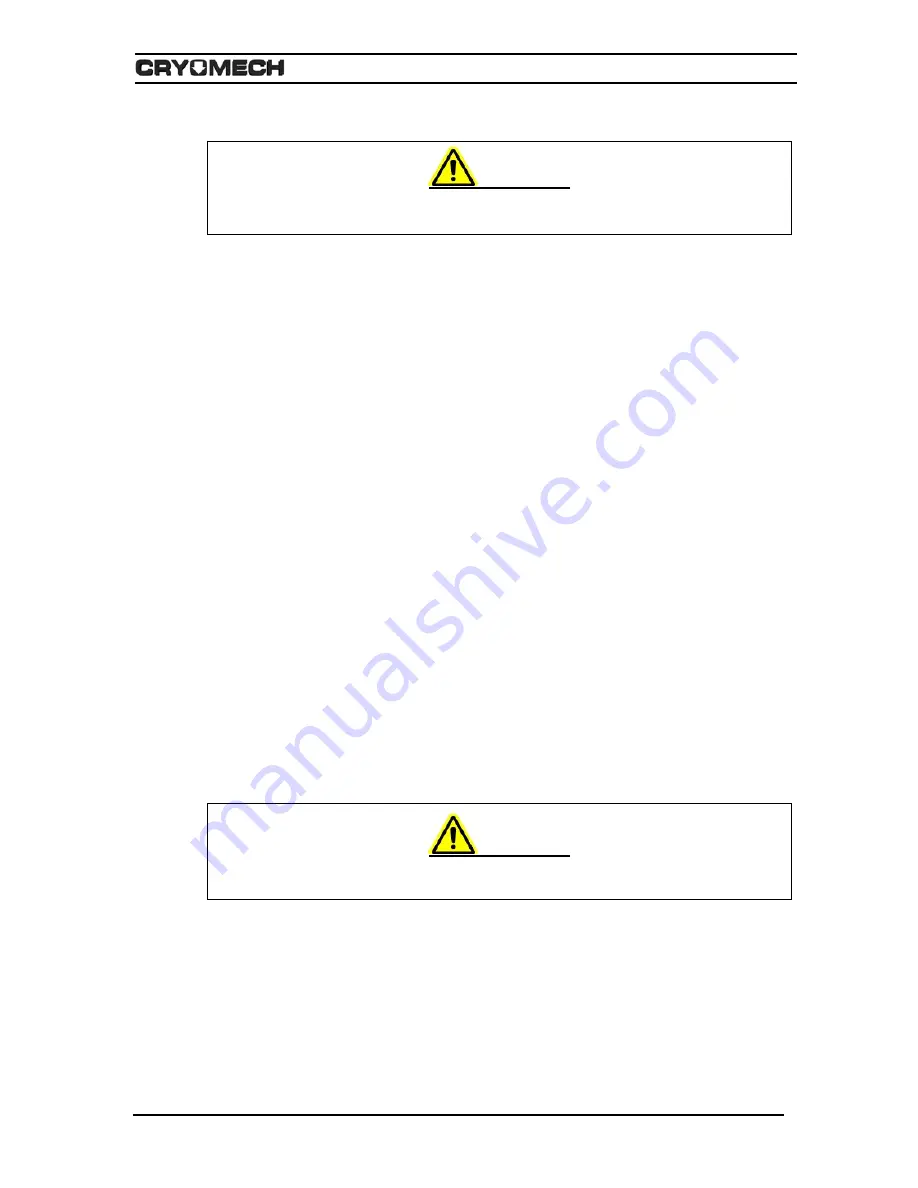
Operation
7-7
7.6 Extracting liquid nitrogen
WARNING
Before extracting liquid nitrogen from the dewar, carefully read the following safety
precautions. Improper handling of liquid nitrogen may result in serious injury or death.
•
Transferring and handling liquid nitrogen can be extremely hazardous if the proper
precautions are not taken. The hazards associated with liquid nitrogen are exposure
to cold temperatures, over pressurization of inadequately vented vessels due to the
expansion of small amounts of liquid into large volumes of gas, and asphyxiation due
to the displacement of oxygen in the air in confined areas.
•
Liquid nitrogen is a colorless, odorless, extremely cold liquid, -320
°
F (196
°
C), and
can produce cryogenic burns of the skin and freeze underlying tissue almost
instantaneously upon contact. The recommended personal protective equipment for
handling liquid nitrogen includes a full face shield over safety glasses, loose-fitting
thermal insulated or leather gloves, long sleeve shirts, boots and trousers without
cuffs. Never tuck trousers inside the boots. Gloves should be loose fitting so they can
be quickly removed if liquid nitrogen is spilled on or in them. Insulated gloves are not
made to permit the hands to be put into liquid nitrogen. They will only provide short-
term protection from accidental contact with liquid nitrogen.
•
Liquid nitrogen vaporizes into large amounts of gas. One liter of liquid nitrogen will
vaporize to 694 equivalent volumes of gas at room temperature, 68
°
F (20
°
C). When
filling a vessel with liquid nitrogen, make certain the vessel is adequately vented. If a
sufficient amount of liquid nitrogen is vaporized in a closed container, it will produce
enormous pressures that could rupture the vessel. For this reason, pressurized liquid
nitrogen vessels must be protected with multiple pressure relief devices.
•
As liquid nitrogen vaporizes the resulting gas displaces the oxygen in the air. Since it
is odorless, colorless, tasteless, and non-irritating, the undetectable gas can reduce
the air’s oxygen content below the level needed for safe breathing. Inhalation of
nitrogen in excessive amounts can cause dizziness, nausea, vomiting, loss of
consciousness, and death. At low oxygen concentrations, unconsciousness and
death may occur in seconds without warning. Thus, liquid nitrogen must be stored
and used only in a well-ventilated area. Oxygen monitors are recommended
whenever liquid nitrogen is handled in enclosed areas.
WARNING
If a large spill of liquid nitrogen occurs, open all windows and doors to ventilate the
area.
•
The white colored vapor cloud observed when working with liquid nitrogen is
condensed moisture and extremely cold nitrogen gas. When exposed to cold
nitrogen gas, delicate tissues such as those of the eyes can be damaged even when
the contact is too brief to affect the skin of the hands and face.
Liquid nitrogen can be extracted from the dewar at any time. The pressure inside the
dewar pushes the liquid nitrogen out of the dewar. Use the flexible, stainless steel
extraction line to remove liquid nitrogen from the dewar. The valve and extraction line are
Содержание LNP-40
Страница 1: ...Model LNP 40 Liquid Nitrogen Plant INSTALLATION OPERATION and ROUTINE MAINTENANCE MANUAL...
Страница 4: ...1 1 N Section 1 Overview...
Страница 10: ...2 1 N Section 2 Warranty...
Страница 13: ...3 2 N Section 3 Safety...
Страница 25: ...4 1 N Section 4 Inspection and Unpacking...
Страница 29: ...5 3 N Section 5 Specifications...
Страница 50: ...6 1 N Section 6 Installation...
Страница 67: ...7 2 N Section 7 Operation...
Страница 87: ...8 1 N Section 8 Routine Maintenance...
Страница 98: ...Appendix Spray Lubricant Instructions...
















































